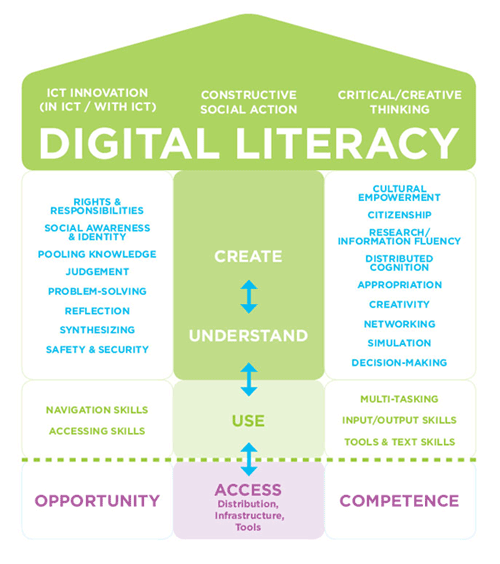
It’s been almost fifteen years since Mark Prensky coined the term “digital native” to describe young people who have grown up with the Internet and digital media. In fact, the children who were born the year Prensky’s book was published are now in high school. While for many, the public perception of young people taking to digital platforms like ducks to water persists – accompanied by the image of adults, particularly parents, who are seen (often by themselves) as hopelessly out of their depth – the question remains how close that image is to reality. Are Canadian youth truly digitally literate? And if they are not "digital natives" who effortlessly acquire their skills on their own or from peers, are students learning what they need from their parents or teachers?
That’s the question that MediaSmarts has tried to answer in our report Experts or Amateurs? Gauging Young Canadians’ Digital Literacy Skills, using data drawn from our study Young Canadians in a Wired World, Phase III, in which we surveyed more than five thousand students from every province and territory across Canada. The report looks at students’ skills from a perspective of MediaSmarts’ definition of digital literacy, which illustrates the many interrelated elements that fall under the digital literacy umbrella.
Use is the element of digital literacy that is usually most readily apparent, and it’s also the aspect where youth are most likely to give a good impression. Nearly all students use digital technology outside of school and they engage in a wide range of activities through digital platforms such as social networks, video streaming sites, and online games. When we look past the surface, however, the picture becomes more complicated. Search engines are a good example: while Google is one of the most popular websites among students, just over a third use advanced search engine tools and only half scan the full first page of search engine results before clicking on one.
Students also rely on Wikipedia as a source of information – despite many having been told by teachers not to use this online reference. While the popularity of Wikipedia among students is not necessarily cause for alarm (and may be in part due to the high ranking of Wikipedia articles in Google search results) the fact that several students in our 2012 focus groups described it as their primary source of information suggests that Canadian youth take a “satisficing” approach to many digital tasks, learning – and applying – only the skills they consider essential to the context.
Students’ use of social networks shows further evidence of this concept. While they demonstrate fairly sophisticated abilities to use social networks’ tagging and blocking features and privacy settings to manage what information about them is seen by their friends, family and community – something of obvious relevance to young people – they generally overestimate how much these sites’ privacy policies limit how their data may be used by the companies that own them. Similarly, a quarter of students express confidence that they would be able to access websites that are blocked by school filtering programs. Older students are more likely to say this than younger ones, and are also more likely to say that they have had trouble finding information because of those filters. In both cases, students’ Use skills are greater if they are seen as being immediately relevant.
When turning to students’ ability to Understand digital media, we can see that many students use a “satisficing” strategy not just in terms of what skills they learn but when they apply them. Whether or not students try to authenticate online information depends largely on what they need it for: almost all students say they make an effort to verify information they’re seeking for school, close to three-quarters verify information they’re providing to a friend or family member and two-thirds verify information they are seeking for their own personal interest. This suggests that youth are more likely to apply digital literacy skills when they see a likelihood of immediate consequences: when they will be graded, for example, or when friends or family members are relying on them. Context is an important element as well: youth are least likely to try to verify something they learn through social media. The number of students who verify information in all contexts except school is higher among older students, which could be due to an increase in skepticism or to more exposure to digital literacy instruction. However, the number of students who verify information being researched for school is largely consistent across grades, suggesting that even the youngest students are aware of the need to verify online information, but only those in the later grades apply those skills in non-school contexts.
When students do try to verify information they’ve found online, how good are they at it? Overall, six in ten students use some of the authentication strategies that were asked about, with the most popular strategy – looking to see if other sources give the same information – used by seven in ten students. This suggests that this strategy, often called the “triangle method” due to the suggestion that students find three sources with the same information, is one of the most often taught to students. Considering students’ use of sources such as Wikipedia and the frequency with which they share links to news and other information through social media, it’s clear that students need both to improve their authentication skills and to use them more often.
As with other digital literacy skills, students do create some digital content fairly frequently: almost three-quarters of students post comments or pictures on their own social network sites, and one in six do so once a day or more. More than a third have posted a story or artwork they created themselves, though of these only one in five do so at least once a year. Just a third of students post video or audio files of themselves, possibly because while in theory anyone can post a video on YouTube and similar sites, in practice there remains a relatively small number of content creators; for youth, the culture of YouTube is largely one of consuming media, not creating it. On the other hand it is probable that a significant number of youth are creating content using Minecraft, the number seven site overall and the number two site among boys in grades 4-6, because content creation is seen as a normal part of the game activity and is rewarded within the game’s culture.
As well as appraising students’ levels of digital literacy, the study examines the equally important questions of how they are learning digital literacy skills. Nearly all students say they have learned about finding online information, with parents and teachers being equally frequent sources. Four in five students say they have learned to authenticate the information they find, and here they are more likely to say they learned this from teachers. This may reflect lower confidence and skill levels among parents when it comes to authentication, compared to search skills. Students were more likely to say that their parents had taught them how to use privacy settings on social networks – a practical skill that might be seen as a safety concern – while teachers were a more common source for learning about how corporations collect and use personal data, a more abstract issue. There is no consistent pattern across grades in the number of students who have learned digital literacy skills at school , suggesting that these skills have not yet found a place in the curriculum and, when they are taught, occur as a one-off rather than part of a larger digital literacy framework.
Overall, girls are more likely than boys to have learned digital literacy skills from teachers. This may be because girls pay more attention to their teachers, or that girls seek out additional instruction on the topic from them. The latter possibility is worrying because it suggests, again, that digital literacy skills are not yet part of standard classroom content, but rather are only available to students who have the interest and agency to ask for them. However, it is true that boys are generally more likely to have learned about digital issues from online sources, which could suggest that they learn these skills earlier and independently and therefore already feel competent by the time the skills are addressed in school.
Another issue affecting students’ education in digital literacy skills may be the role of technology in the classroom. While a large number of students report that their schools have teacher-focused digital technologies, a much smaller number say they are able to use their own digital devices and less than a third say their teachers have ever used social media to help them learn (although this number rises to 39 percent of students in grades 9-11). When students are able to use the digital devices and platforms they are most familiar with, they mostly use them in ways that are essentially the same as traditional classroom activities. This is a concern because integrating technology in this way may make the digital literacy education students receive in school seem less relevant because it has little connection to their digital lives outside of school. This is something that educators need to consider, as our assessment of students’ digital literacy skills shows that relevance is of prime importance in determining both which skills students learn and whether they choose to use them.
Future reports based on the Young Canadians in a Wired World student survey data will look at: offensive content and online relationships and sexting.
Click here to read the full report: mediasmarts.ca/ycww.
Young Canadians in a Wired World, Phase III: Experts or Amateurs? Gauging Young Canadians’ Digital Literacy Skills was made possible by financial contributions from Canadian Internet Registration Authority, Office of the Privacy Commissioner of Canada and The Alberta Teachers’ Association.

